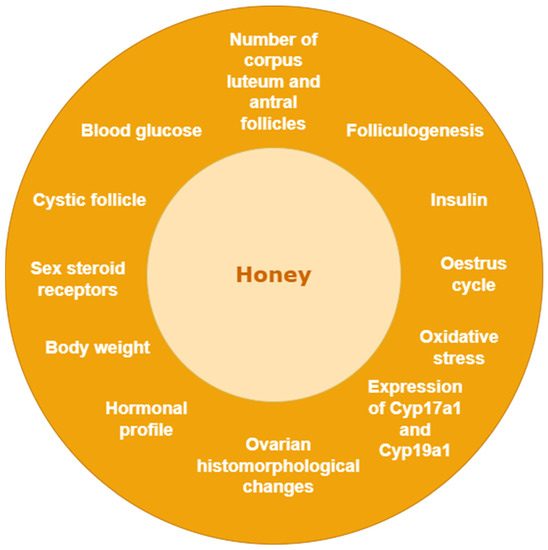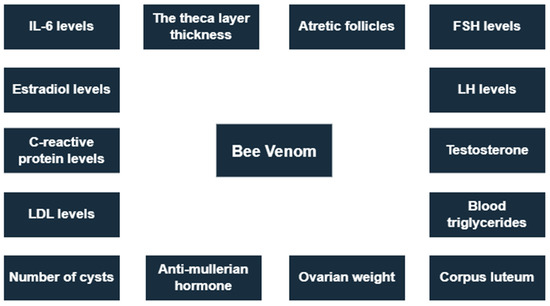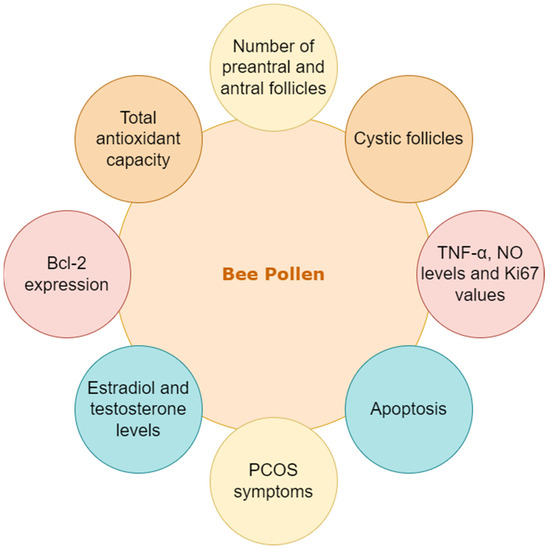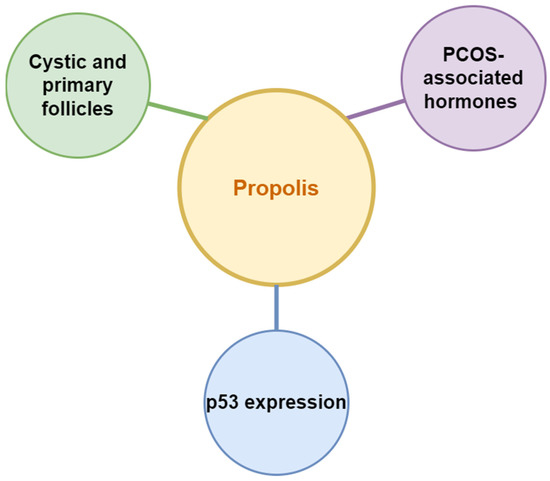Bee products, including honey, have been utilized since ancient times for nutritional and therapeutic purposes. Other bee products such as bee pollen, royal jelly, and propolis have caught a lot of attention. Being high in antioxidants and bioactive compounds, these products have established their applications in the pharmaceutical field as supplementary or alternative medicines. Polycystic ovarian syndrome (PCOS) as a hormonal disorder in which the ovaries produce an irregular quantity of androgen. Bee products, especially honey, have been used since ancient times as a safer alternative to sugar. Being rich in antioxidants, honey indirectly helps PCOS patients by lowering the risk of oxidative stress, inflammation, and type-2 diabetes.
1. Honey
Ancient literature mentions honey as a product used for its nutritional and healing properties. Honey comprises a supersaturated solution of carbohydrates (90–95% of dry mass) mixed with approximately 17% of water [
20]. The characteristics of honey vary depending on the floral source, type of bee, environmental conditions, and/or extraction, processing, and storage conditions of packed honey [
21]. Moniruzzman and colleagues identified more than 400 volatile and semivolatile compounds in honey which include C13-norisoprenoids, benzyne derivatives, monoterpenes, sesquiterpenes, fatty acids, alcohols, aldehydes, esters, and a wide array of organic acids such as aspartate, acetate, alpha-ketoglutarate, shikimate, etc. [
22,
23]. Although honey has been proven to have innumerable therapeutic properties, direct evidence of the use of honey in PCOS treatment is limited. Honey affected parameters related to PCOS were presented in
Figure 3.
Figure 3. Honey-affected parameters related to PCOS.
Letrozole as a nonsteroidal aromatase inhibitor reduces the extent of estrogen released by the body and is widely used for inducing PCOS-like symptoms in rats. Letrozole-induced PCOS causes downregulation of leukemia inhibitory factor (LIF), bone morphogenetic protein (BMP), and the Kit Ligand (KITL) [
25]. Kelulut honey (KH) almost did not affect LIF expression; however, it could significantly reverse KITL and BMP-1 downregulation [
7]. An increase in ovulation rate causes an increased number of corpus luteum, and the presence of antral follicles indicates the occurrence of folliculogenesis. The research also showed the histological beneficial effects of KH wherein the anomaly caused by letrozole was reversed by KH used in combination with metformin and clomiphene, and the treated PCOS rats showed high counts of corpus luteum and antral follicles, while cystic follicles number had decreased considerably [
8].
In rodent ovaries, upregulation of gene expression of Cyp17a1 protein is observed in theca cells of large antral and preovulatory follicles [
26]. KH has been reported to decrease the Luteinizing hormone (LH) hypersecretion which in turn reduces Cyp17a1 overexpression [
10]. Tualang honey was found to mediate an antidepressant effect on stressed ovariectomized rats. The mechanism for this is unknown; however, the researchers believe the outcome could be possibly by reversal of anomalies in the hypothalamic–pituitary–adrenal axis or by elevation in the brain-derived neurotrophic factor concentration [
27] Aberrant expression of Estrogen receptors alpha (ERα) and beta (ERβ) causes folliculogenesis and ovulatory dysfunction in PCOS patients [
28]. Kamal and colleagues found out that KH-fed rats showed significant restoration of mRNA expression of both ERα and Erβ, while another study reports downregulation of ER expression by Taulang and Manuka honey [
9,
29].
No direct evidence of the use of honey in the treatment of PCOS or its symptom relief has been reported in human trials. Most herbal medicines used in PCOS use honey as a demulcent [
21].
2. Honeybee Venom
Bee venom (BV) is poison released by female worker bees in the hive that is responsible for bee stings. Just like other venoms produced by different animals, bee venom is also studied for its therapeutic properties. Some of the most commonly known active constituents of bee venom are melittin, adolapin, apamin, and MCD-peptide—a complex blend of peptides. Bee venom is also rich in enzymes such as PLA2 and bioactive amines (e.g., epinephrine and histamine), and minerals. The established components of bee venom are studied for various human diseases, namely, amyotrophic lateral sclerosis, neurodegenerative diseases such as Alzheimer’s and Parkinson’s diseases, and different classes of cancers. Bee venom has also shown extraordinary antiviral activity against human immunodeficiency (HIV). Recently, the effects of bee venom have also been studied in the neuroendocrine segment for disrupted hormonal secretion affecting fertility in women [
3]. Bee venom affected parameters related to PCOS were presented in
Figure 4.
Figure 4. Bee venom affected parameters related to PCOS.
Studies conducted showed the effective modulatory effect of honey bee venom on hyperglycemia with regard to hyperandrogenism in PCOS-induced Wistar rats. Additionally, a decreased hormonal level of Testosterone and Estradiol along with decreased blood sugar levels was observed in HBV-treated rats. Some noteworthy morphological changes were also noted in the reproductive organ in HBV-treated rats in comparison to the PCOS group. The thickness of the theca layer, the number, as well as the diameter of the cyst developed in the ovary were significantly decreased. Moreover, increased corpus luteum, a healthy sign of ovulation, was observed in HBV-treated ovaries. The beneficial effect of HBV against PCOS may be due to the inhibitory effect of HBV on TNF𝛼 level [
19].
COX-2 involvement is observed during inflammation and extensive cell proliferation which is influenced by prostaglandin synthesis. COX-2 in PCOS has a major proliferative effect on the theca layer of the ovary where the process of ovulation takes place. The overexpression of COX-2 is through TNF𝛼 affecting the thickness of the theca layer of the ovary [
31].
Attempts to study the effect of HBV on Anti-Mullerian Hormone (AMH) and lipid profile. Decreased levels of blood triglycerides and low-density lipids were observed in the HBV-treated PCOS group of rats. Similar results were observed in the case of AMH when treated with HBV. The benefits of HBV were successfully observed in the suppression of AMH factor and significant suppression of LDL and triglycerides levels [
17]. The reduction in lipid levels in PCOS can regulate the hyperandrogenism in the disorder.
One of the most innovative studies for managing PCOS involves a laparoscopic bilateral intraovarian injection of bee venom. The 15 subjects of PCOS, resistant to medical treatment, were injected with 0.1 mL of BV into the ovarian stroma. The results of the study indicated a reduction in LH, androstenedione, and testosterone in the subjects, promoting ovulation by 70%, and the pregnancy rate was 50% in those who showed signs of ovulation with no complication [
32].
PCOS exhibits a variety of symptoms which can be categorized based on physical, psychological, metabolic, and neuroendocrine leading to reproductive dysfunction. These symptoms often lead to the manifestation of each other. Bee venom in general might be toxic in nature, and hence, its consumption for treatment of PCOS does not seem feasible. In a study of 46 PCOS patients divided into two groups who were on a high-low-calorie diet, participants were subjected to bee venom phonophoresis. Phonophoresis is a non-invasive technique that implies use of ultrasound waves to increase the transdermal drug delivery process. After 7 and 14 weeks of the treatment, a significant decrease in LH and LH/FSH ratio was observed. The treatment proving BV phonophoresis with guided physical activity and proper diet has a positive effect in managing obese PCOS women [
15]. This is one of the exclusive examples of the use of a bee product wherein a direct indication of the effectiveness of bee venom on the treatment of PCOS is available.
3. Royal Jelly
Secreted by the hypopharynx of nurse bees, royal jelly is a honeybee secretion that is primarily used to meet the nutritional needs of growing larvae and adult queens. While developing a new queen bee, the workers construct special queen cells. The larvae in the specialized cells are constantly fed with an abundant amount of royal jelly to facilitate the development of mature queen morphology for fully grown and developed ovaries required to lay many eggs. The chemical composition of royal jelly is believed to favor such a type of development in queen bees. An amount of 60–70% of the royal jelly is composed of water, different forms of sugar, dicarboxylic acid, and a rare and unique type of short hydroxy fatty acid with 8–12 C atoms [
33]. Most important fatty acids found in royal jelly are sebacic acid (SA), 10-hydroxy-2-decanoic acid (10-H2DA), and 10-hydroxydecanoic acid (10-HDA) [
34]. A wide variety of proteins is dominant ingredients of royal jelly that are composed of nine major proteins of 49–87 kDa. Phosphorylation and glycosylation of these proteins are crucial for some vital biological processes involving glycoproteins, such as immunity, cell adhesion, differentiation, and growth. These major proteins of royal jelly regulate the development of female larvae and contribute to cell proliferation, cytokine suppression, etc. [
35]. Apart from this major component, royal jelly also constitutes a diverse variety of phenolic compounds, free amino acids, carbohydrates, biogenic elements, vitamins, and some bioactive substances [
36]. Royal jelly affected parameters related to PCOS were presented in
Figure 5.
Figure 5. Royal jelly affected parameters related to PCOS.
Royal jelly shows a significant effect in promoting ovarian follicle growth in immature rats. A study showed that a significant increment in ovarian and uterine weights also increased the serum levels of estradiol and progesterone. Along with the hormonal increase, a substantial enhancement in the quantity of corpora lutea and mature follicles was observed. The rats divided into four groups were subjected to 100, 200, and 400 mg/kg/day doses of royal jelly and showed improved folliculogenesis and an increase in ovarian hormones [
37]
4. Bee Pollen
Bee pollen is raw material collected by the worker bee to produce bee bread and ambrosia. This is the flower pollen collected by the worker bee and it is also a primary source of food in the hive. Bee pollen consists of varied plant-based compounds with expressed bioactivities [
39]. It is also recognized as an excellent functional food ingredient [
40]. Basic chemical substances such as important amino acids, proteins, carbohydrates and sugars (mainly fructose and glucose), lipids (such as linoleic, γ-linoleic, archaic, and Phospholipids) and fatty acids, and phenolic compounds (including catechins, flavonoids, phenolic acids, and leukotrienes) are presented in bee pollen [
41]. Among flavonoids, there are mainly quercetin, isorhamnetin, kaempferol, and their derivatives, while in the group of phenolic acids, there is mainly chlorogenic acid), coenzymes, and enzymes as well as vitamins and bioactives (such as provitamin A and vitamins B1, B2, B6, C, D, and E, and acids: folic, pantothenic and nicotinic, and rutin, inositol, and biotin) [
41,
42,
43]. Bee pollen affected parameters related to PCOS were presented in
Figure 6.
Figure 6. Bee pollen affected parameters related to PCOS.
5. Propolis
Propolis is a waxy material produced by honeybees by collecting plant substances from different parts including exudates and buds. Generally, bees use propolis as a protective and constructive substance to protect the hives from any external invaders and extreme environmental conditions and repair their hives, respectively. However, propolis is known to have many beneficial effects on human health. Propolis is composed of waxes, resin, pollen, essential oils, and other organic compounds [
44,
45]. Chemical compounds such as: phenolics; benzoic acids and derivatives; cinnamic acid and its derivatives and cinnamic alcohol; triterpene and sesquiterpene hydrocarbons; benzaldehyde derivatives; other acids and respective derivatives; ketones, alcohols, and heteroaromatic compounds; terpene and sesquiterpene alcohols and their derivatives; aliphatic hydrocarbons; biogenic elements; steroid hydrocarbons and sterols; amino acids; and sugars are presented in propolis [
46,
47]. Propolis is known for its antioxidant, antibacterial, antifungal, antitumoral, and antidiabetic activities, and along with these activities, it has also shown a prominent result in allergies, rhinitis, and asthma [
47]. Propolis-affected parameters related to PCOS are presented in
Figure 7.
Figure 7. Propolis affected parameters related to PCOS.
A study was conducted to understand the effect of propolis in PCOS rats and examined the effect of 50 and 150 mg/kg of propolis on p53 expression, ovarian folliculogenesis, serum progesterone, and LH level in PCOS rats. Experimental animals were divided into four different groups and were induced with letrozole for 21 days. The group which received propolis after 21 days of administration for 10 days showed a significant decrease in the number of cystic follicles comparing to the untreated group with a significantly higher level of LH in the propolis-treated group. However, there was no significant difference seen in the circulating P levels. Additionally, p53 immunoreactivity was not seen in any group. The study concluded that low concentrations of propolis cannot entirely improve the hormonal profile and the expression of p53 in PCOS; however, these concentrations can successfully control the ovarian follicular cell structure [
11]. No human trial data are available on the use of propolis for PCOS management/treatment.
This entry is adapted from the peer-reviewed paper 10.3390/nu15051165





